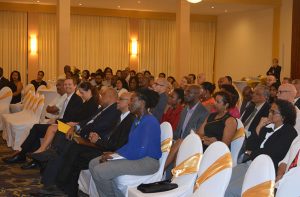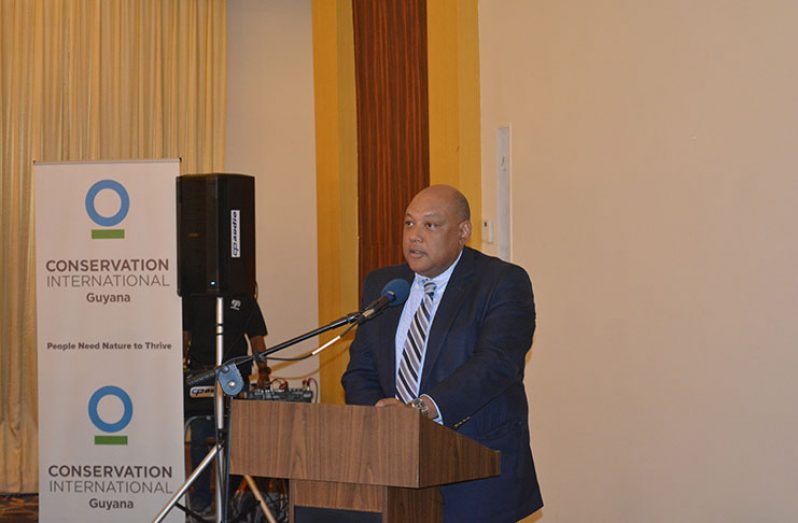AGAINST the backdrop of unprecedented gold declarations in 2016, the Global Environment Facility (GEF) will, over the next four years, invest US$3M in the phasing out of mercury in the extraction of gold here and in seven other countries by 2025.The full title of the Global Opportunities for Long Development (GOLD) project is: ‘A supply chain approach to eliminating mercury in Guyana’s Artisanal and Small Gold Mining (ASGM) sector: El Dorado Gold Jewelry – Made in Guyana’.
The eight-country project is being implemented by the United Nations Environment Programme (UNEP), and aims to help business enterprises and other stakeholders in the gold sector shift towards mercury-free practices by 2025.
In Guyana, the project is being executed by Conservation International Guyana (CIG), and was officially launched on Tuesday evening at the Pegasus Hotel. GOLD is built around Guyana’s commitment to the Minamata Convention on Mercury, which is a global treaty to protect human health and the environment from the adverse effects of mercury.
MAJOR HIGHLIGHTS
According to a public statement from CIG on the project: “Major highlights include a ban on new mercury mines; the phase-out of existing ones; the phase-out and phase-down of mercury use in a number of products and processes; control measures on emissions to air and on releases to land and water; and the regulation of the informal sector of artisanal and small-scale gold mining.”
The Convention will also address the interim storage of mercury and its disposal once it becomes waste; sites contaminated by mercury, as well as health issues.
According to CIG Vice-President, Dr. David Singh, specific outcomes of the project are: The establishment of a demonstration area for technology transfer; a financial mechanism for capital investments for mercury-free technologies; a chain-of-custody process and verification mechanism for branded Guyana gold that is linked to international responsibly-produced gold markets; a national policy on responsible gold production and value-added and requisite laws/regulations refined/drafted to support a responsible gold commodity chain; and education and awareness on options and benefits of responsible gold production and targeting policymakers in particular.
He said the project will also include a programme for the regular monitoring of project activities against targets and outcomes, and the management of risk to adapt the project activities to meet targets and contribution to a global strategic communications programme.
BUILDING BRIDGES
“CI’s work is about building bridges and partnerships,” Dr Singh said, adding, “So far in our initiative, I’ve witnessed what is possible if we take a longer view of issues, where problems are seen as things that need to be resolved rather than seeing them as the excuse to walk away.”

Some 30 persons from different parts of the gold value chain, he said, sat together on Tuesday to develop detailed plans for the implementation of the initiative.
He said that over the next four years, this same kind of interaction will be carried out so as to help solve the problems of people on the ground.
Speaking, too, at the forum was Minister of Governance, Mr Raphael Trotman who said that expressions of frustration in the media and elsewhere only serve as a reminder of the tensions that exist between small and medium-scale miners, and between miners and the government over land and resources.
REASON TO CELEBRATE
He noted that while the launching of the project at hand is reason to celebrate, all stakeholders ought to be mindful of the fact that besides preserving the environment, uppermost on the government’s agenda is life and good living.
This being the case, he said, the project captures and addresses the essence of the many issues that the government seeks to manage in an extractive industry’s sector that is bracketed within a ‘green’ and sustainable development agenda.
That said, Minister Trotman went on to laud the contributions of the mining sector, particularly the small and medium-scale gold mining aspects of it, to the economy, which accounted for 11 per cent of Guyana’s GDP in 2016.
He said that in 2016, the sector not only generated approximately US$700M in foreign exchange, but also proved to be the main source of employment and revenue for hinterland communities, including indigenous ones, thereby providing direct employment for over 20,000 people.
Other presenters at the launch included CIG Senior Vice-President, Dr. Sebastian Troeng; GEF Director of Programmes, Dr. Gustavo Fonseca; Head of the Ministry of the Presidency’s Department of Environment, Ndibi Schwiers; and Mr Hilbert Shields, Executive Member of the Guyana Gold and Diamond Miners’ Association (GGDMA).



.jpg)








